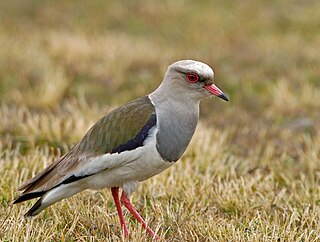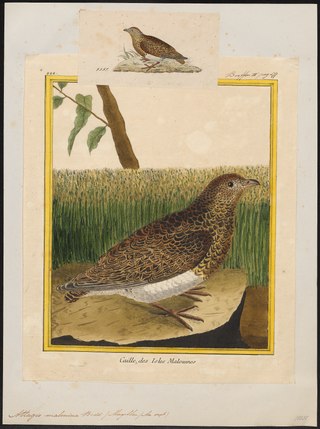
The rufous-bellied seedsnipe is a bird in suborder Scolopaci of order Charadriiformes, the shorebirds. It is found in Argentina, Bolivia, Chile, Ecuador, and Peru.

The white-throated hawk is a bird of prey in subfamily Buteoninae, the "soaring" hawks, of family Accipitridae. It is found in Argentina, Bolivia, Chile, Colombia, Ecuador, Peru, and Venezuela.

The grey-fronted dove is a large New World tropical dove. It is found on Trinidad and in every mainland South American country except Chile.

The puna snipe is a bird in tribe Scolopancinai and subfamily Scolopacinae of family Scolopacidae, the sandpipers and relatives. It is found in Argentina, Bolivia, Chile, and Peru.

The plain-mantled tit-spinetail is a small passerine bird of South America in the Furnariinae subfamily of the ovenbird family Furnariidae. It is found in Argentina, Bolivia, Chile, and Peru.

The common miner is a passerine bird in the subfamily Sclerurinae, the leaftossers and miners, of the ovenbird family Furnariidae. It is found in Argentina, Bolivia, Brazil, Chile, Peru, and Uruguay.

The two-banded plover is a species of bird in subfamily Charadriinae of family Charadriidae. It is found in Argentina, Brazil, Chile, the Falkland Islands, and Uruguay.

The tawny-throated dotterel is a species of bird in the family Charadriidae, the plovers and their relatives. It is found in Argentina, Bolivia, Brazil, Chile, Peru, and Uruguay.

The Andean lapwing is a species of bird in family Charadriidae, the plovers and their relatives. It is found in Argentina, Bolivia, Chile, Colombia, Ecuador, and Peru.

The white-throated quail-dove is a species of bird in the family Columbidae. It is found in Argentina, Bolivia, Colombia, Ecuador, and Peru.

The black-winged ground dove is a species of bird in the family Columbidae. It is found in Argentina, Bolivia, Chile, Colombia, Ecuador, and Peru.

The plumbeous rail is a species of bird in the subfamily Rallinae of the rail, crake, and coot family Rallidae. It is found in Argentina, Bolivia, Brazil, Chile, Ecuador, Paraguay, Peru and Uruguay.

The sharp-billed canastero or lesser canastero is a species of bird in the Furnariinae subfamily of the ovenbird family Furnariidae. It is found in Argentina, Bolivia, Chile, Paraguay, and Uruguay, and has also occurred as a vagrant in Brazil.

The grey-flanked cinclodes, formerly known as Oustalet's cinclodes, is a species of bird in the Furnariinae subfamily of the ovenbird family Furnariidae. It is found in Argentina and Chile.

The mountain wren is a species of bird in the family Troglodytidae. It is found in the Andes of northwestern Argentina, Bolivia, Colombia, Ecuador, Peru, and western Venezuela.

The scale-throated earthcreeper is a species of bird in the Furnariinae subfamily of the ovenbird family Furnariidae. It is found in Argentina, Bolivia, Chile, Peru, and possibly Uruguay.

The straight-billed earthcreeper is a species of bird in the Furnariinae subfamily of the ovenbird family Furnariidae. It is found in Argentina, Bolivia, Chile, and Peru.

The white-bellied seedsnipe is a species of bird in suborder Scolopaci of order Charadriiformes, the shorebirds. It is found Argentina and Chile.

The least seedsnipe is a xerophilic species of bird in the Thinocoridae family.

The cream-winged cinclodes is a species of bird in the Furnariinae subfamily of the ovenbird family Furnariidae. It is found in Argentina, Bolivia, Chile, and Peru.





















